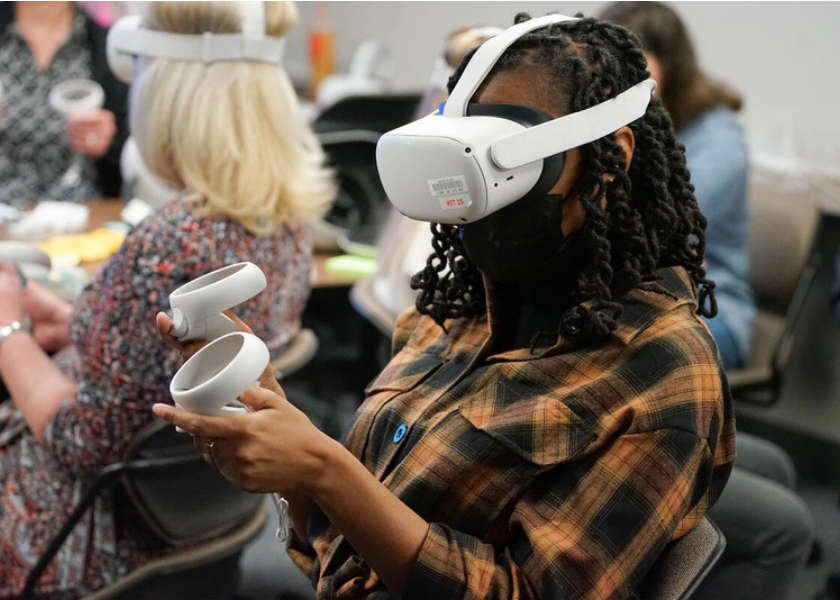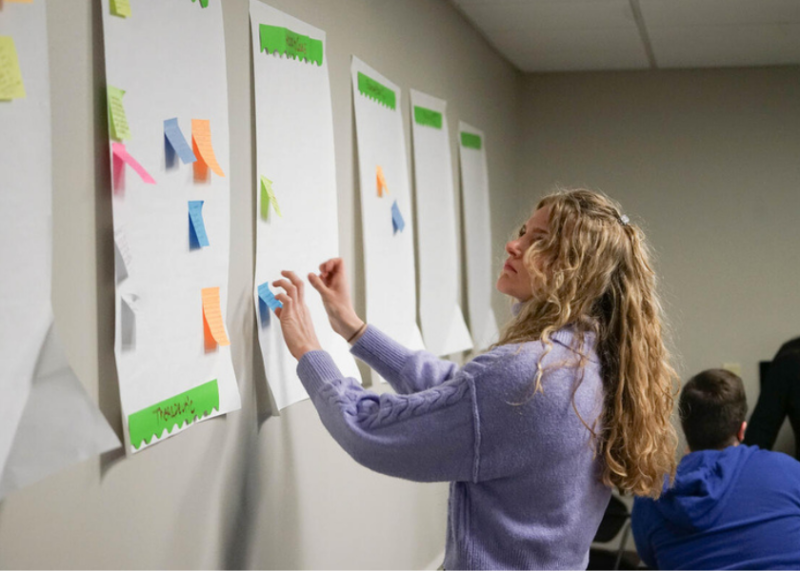Nursing students try on VR technology that could benefit patients and nurse well-being
Although physically in a classroom at the Vanderbilt University School of Nursing, a group of students were far, far away, virtually experiencing campfires, galaxies, snowfall and other relaxing settings.
The Psychiatric-Mental Health Nurse Practitioner students were exploring how virtual reality can be used in health care and education, taking part in an innovative VUSN pilot program called SparkleVille, which uses technology to enhance kinesthetic learning. The program also offers learning opportunities for nursing informatic students as part of their practicum.
“Students read research papers about virtual reality and are entrenched in didactic learning, but we wanted to provide an opportunity to experience the technology firsthand,” explained Assistant Professor and Skills and Simulation Lab Director Jo Ellen Holt, DNP. “The trial run gave students the opportunity to use VR and even consider prescribing it to clients in the future.”
The idea and VR class stemmed from a startup called Very Real Help, Inc. founded by Vanderbilt Psychological Sciences Ph.D. candidate Noah Robinson, who studies clinical psychology and cognitive behavioral therapy in the College of Arts and Science. Kelly Aldrich, DNP, FHIMSS, VUSN Associate Professor and Director of Informatics Innovation, was introduced to Robinson through her projects at the Wond’ry, Vanderbilt’s Center for Innovation and Design. Very Real Help was spun out of the Wond’ry and has raised over $2MM to build its virtual reality clinical research platform. Robinson’s startup created a free VR app, Help Club (app.helpclubvr.com), to allow people to join peer-led mental health groups and experience calming situations. Aldrich thought it would provide a great opportunity to enhance nursing education.
Leaders of VUSN’s highly ranked Psychiatric-Mental Health Nurse Practitioner program agreed, always seeking ways to bring new experiences to their students.
After donning VR headsets, the students experienced the app’s areas of relaxation for themselves. When asked about the experience, most found it relaxing. They could see it being used for therapy, chronic pain management, working through fears and to offer unique experiences to people in nursing homes or hospice care.

A nursing student wears a virtual reality headset to see how the experience might help alleviate stress and how it might be useful for patients. | Photo by Caroline Taylor
“Initially the students were excited to try something new other than lecture,” Holt explained. “Some were skeptical or just had never considered VR environments. They had the courage to try and found it to be beneficial.”
Students shared their thoughts on Post-it notes mounted on a wall under different categories, including future applications/benefits, lingering questions, etc.
“Immersive virtual reality is the most interpersonal and anonymous technology—it simultaneously allows people to feel as if they are with others while also becoming an anonymous avatar with a username,” Robinson said.

A nursing student places sticky notes with thoughts about the virtual reality experience on the wall. | Photo by Caroline Taylor
Aldrich and Holt plan to set up research projects to see how VR can play a role in nurse support, stress reduction and retention, starting with a dedicated space for School of Nursing students, faculty and staff to try out VR technology for stress reduction later this spring. Some nurses leave the profession after a few years, citing stressful situations, Aldrich said. An app like Robinson’s could offer peace to those working this important, yet emotionally taxing job.
Under the SparkleVille program umbrella, Holt and Aldrich also work to advance innovation in nursing and health sciences through use of 3D printers, a maker’s space and smaller pilot programs.
“The program is a unique opportunity—a spark or magical area—where the two worlds of technology and informatics combine,” Holt said, adding that Sparkle stands for Simulation Projects Advancing Research and Kinesthetic Learning Experiences. “We want to see how we can advance these ideas and disseminate them.”
Aldrich believes VR nurse training will be a fruitful research avenue going forward. Vanderbilt may one day use VR to help students experience everything from empathy training to the positions of internal organs and disease processes.
“We’ve been exploring and pushing innovation in our curriculum,” Aldrich said. “As virtual reality gets better and better, we hope to find ways to advance the simulation environment through immersion experiences.”
Simulation pairs nicely with a virtual environment, offering numerous opportunities for educational experiences and learning critical techniques in a safe space.
“It’s fun to see how faculty are continuously trying to improve the experience for their students through our simulation lab,” Holt said. She said that the school’s simulation team is continually working with informatics faculty to help apply technology in smart ways.
“This interesting approach to education can scale beyond the traditional simulation environment,” Aldrich explained. “It will help as we watch pandemic protocols and want to continue helping students with this advanced learning experience.”
SparkleVille’s VR project, which is poised to support nurse well-being and retention, is being developed through a collaboration between VUSN’s nursing informatics program faculty and its simulation team.
